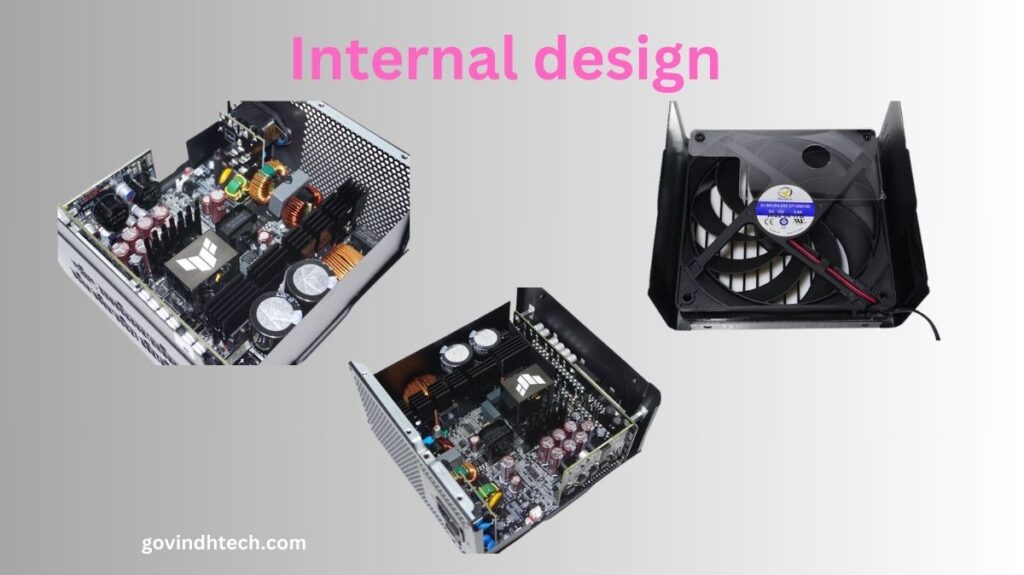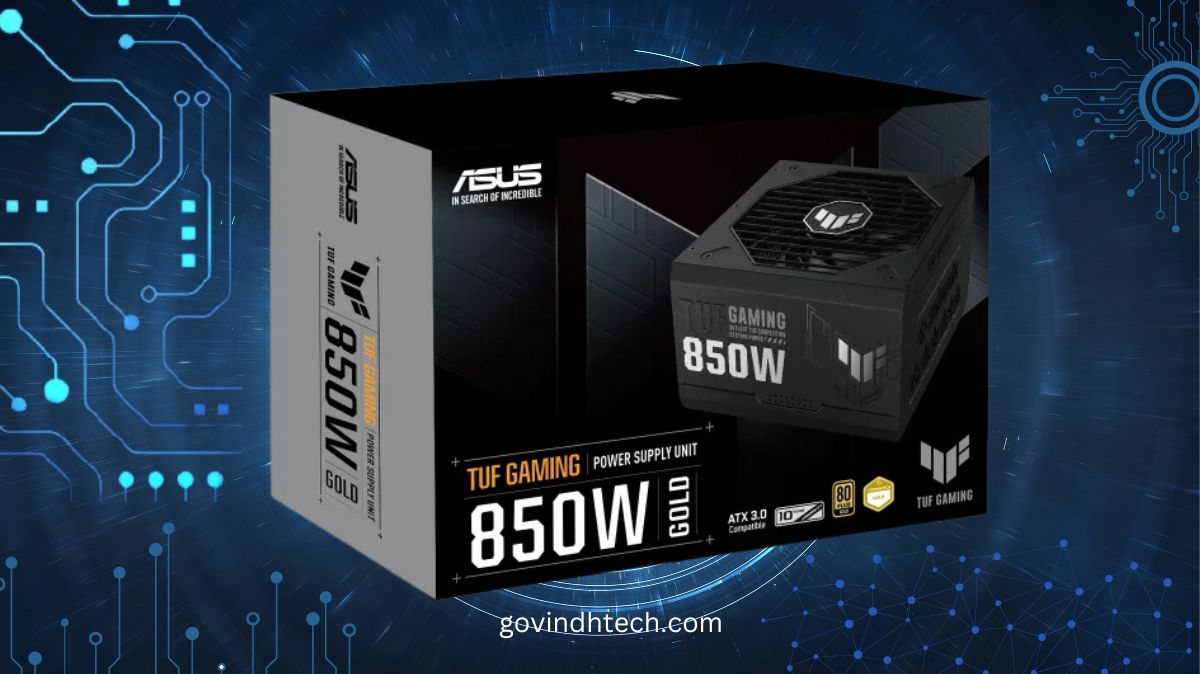The company created subsidiary brands like “Republic of Gamers” or “ROG.” over time, expanding beyond PC motherboards and core components. From mouse pads to gaming laptops, almost every computer accessory and part has the ASUS logo.
For some reason, we’ve never reviewed ASUS’s large power supply unit lineup. ROG, TUF Gaming, and Prime are the company’s three main product lines for upscale markets. Unlike other manufacturers, ASUS avoids the low-to-mid market in favor of the more lucrative premium and gaming segments.
The ASUS TUF Gaming series is the company’s most adaptable, so we’re reviewing it today. TUF Gaming markets products for long-term reliability and high performance. Featuring 80Plus Gold certification and a 10-year manufacturer’s warranty, the new 850W Gold variant of this series meets Intel’s ATX 3.0 design guidelines and is affordable.
| Asus TUF Gaming 850W Gold Power Specifications ( Rated @ 50 °C ) | |||||
| RAIL | +3.3V | +5V | +12V | +5Vsb | -12V |
| MAX OUTPUT | 25A | 25A | 70.8A | 3A | 0.8A |
| 130W | 850W | 15W | 9.6W | ||
| TOTAL | 850W | ||||
| 80 Plus Rating | Gold | ||||
| AC INPUT | 100 – 240 VAC, 50 – 60 Hz | ||||
| MSRP | $111 | ||||
Package and group
ASUS is known for careful packaging, and the TUF Gaming 850W Gold arrives in no exception. The box’s sides and back have intricate artwork and information. The box is sturdy and the item is well-protected for shipping.
The TUF Gaming 850W Gold PSU is well-packaged. Along with the AC power cable, mounting screws, and a thick manual in 30 languages, ASUS includes several cable ties and three high-quality cable straps. The capacitors and chokes have a “certificate of reliability” that lists the tests they had to pass for ASUS to use them. ASUS claimed “military grade reliability” for its products because most were MIL-STD-202 and MIL-STD-810H compliant. The tests are done by Taiwan-based private lab iST.
The TUF Gaming 850W Gold’s modular design allows removal of all DC power cables, including the 24-pin ATX connector. The ATX 24-pin and new 12VHPWR cables are black with black connectors and individually sleeved wires. It’s interesting that a unit with that capacity has few connectors.
| ASUS TUF Gaming Gold | ||
| Connector type | Hardwired | Modular |
| ATX 24 Pin | – | 1 |
| EPS 4+4 Pin | – | 2 |
| EPS 8 Pin | – | – |
| PCI-E 5.0 | – | 1 |
| PCI-E 8 Pin | – | 3 |
| SATA | – | 5 |
| Molex | – | 4 |
| Floppy | – | – |
External Design of ASUS TUF Gaming 850W Gold PSU
The TUF Gaming 850W Gold PSU contradicts ASUS’s “military” marketing. Military designs are meant to be minimal and inconspicuous, but the TUF Gaming 850W Gold PSU’s designer left no part of the body untouched to create an aesthetically pleasing product. This unit has chamfered edges, embossed patterns, graphic prints, and debossed lettering. The chassis is 150 mm deep, so it fits all ATX cases except the smallest.

Both sides of the chassis are heavily decorated, though not identical. A small cooling vent in the series logo is on the left. No cutout on the right; the series logo is printed on the chassis. A sticker with the unit’s electrical specs and certifications covers the top. The TUF Gaming 850W Gold PSU’s bottom fan cutout is hexagonal.
Naturally, the PSU’s modular cable connectors are on the front. A simple white legend is painted on the PSU’s body. The series logo is delicately etched on the front top. The rear has only an on/off switch and an AC power outlet.
Internal design

The TUF Gaming 850W Gold PSU is cooled by a Champion dual-ball bearing engine fan, a Chinese manufacturer rarely found in PC components. For a 135mm fan, the CF1325H12D’s 2100 RPM maximum speed is extreme. ASUS markets the fan as having “axial-tech” technology, a plastic ring connecting the blades’ outer parts to increase pressure.
The TUF Gaming 850W Gold PSU was developed by Great Wall, a Chinese OEM that first gained Western recognition after Corsair used them for several mainstream products. The TUF Gaming 850W Gold meets ATX 3.0 design guide requirements and uses a new platform. Undoubtedly one of the newest Great Wall designs.
The main switch, AC plug receptacle, and some filtering stage components are mounted to a vertical PCB, while the rest are on the main PCB. The standard filtering stage has four Y, two X, and two filtering inductors. We’ve never heard of Leshan Radio Company (GBU15K), a Chinese dual input rectifying bridge manufacturer. Two Rubycon 420V/390F capacitors and a large filtering inductor make up the passive APFC.
Every cooling-required active component before the main transformer is attached to a PCB-length heatsink. The main side inversion circuit uses a half-bridge LLC topology and two switchers from WAYON, a new brand. We couldn’t find a datasheet for these chips (WMJ36N6N65SF2). Given the PSU’s efficiency rating and half-bridge configuration, these low-on-resistance MOSFETs are likely very efficient, but we don’t know their specifications.
Another brand, Jinlibo Electronics 4NA1R4C-A, converts the secondary side of the main transformer to create the 12V line with six transistors. The secondary 3.3V and 5V lines come from the vertical daughterboard, which is connected to the main PCB and vertical PCB with connectors. Nippon Chemi-Con and Nichicon supply solid-state capacitors, while Rubycon supplies all secondary electrolytic capacitors.


[…] first cable less graphics card that is ready for manufacturing from Asus is now available for purchase in China. The card, which goes by the name RTX 4070-O12G-BTF, has a […]
[…] units (PSUs), the fundamental component of every high-performance computer system. SeaSonic is a PSU industry stalwart whose innovative and painstaking engineering have consistently set industry […]
[…] 32-thread central processing unit. The 7940HX was able to find a spot within the specs of the next Asus TUF Gaming A16 model, in contrast to the big launch that was given upon the Ryzen 8000 Hawk Point laptop APUs. […]